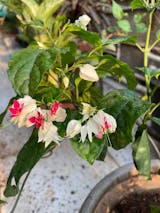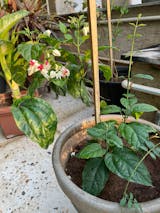Society garlic
Family
Amaryllidaceae
Origin
South Africa
Description
Sweet Garlic is a fast-growing, herbaceous perennial plant that Grows up to 12-20 in. high (30-50 cm) and 9-12 in. wide (22-30 cm).The leaves are long, narrow, strap-like, slightly fleshy and smell strongly of garlic when bruised. They grow from fat, tuberous roots which spread to form clumps of plants.
The pinkish-mauve tubular flowers, clustered into umbels of up to 20 flowers, are held above the leaves on a tall flower stalk, and have a long flowering period. They too smell of garlic when picked. The fruit, triangular capsules, are grouped into a head, and when ripe they split to release the flattened, hard black seeds.
The Zulus use the leaves and flowers as spinach and as a hot, peppery seasoning with meat and potatoes. They also use the bulb to make an aphrodisiac medicine. Wild garlic is a very good snake repellent and for this reason the Zulus plant it around their homes.
Environment
Sweet Garlic grow Easily grown in moderately fertile, light, medium moisture, well-drained soils in full sun. Good heat and drought tolerance, but requires consistent moisture during its growing season. Plants will grow well in shade, but may not flower much.
The planting depth around 2 inches deep so that the shooting points are just above the soil. Plant whole rhizome into the soil leaving just the tips above.
Use a loam based compost with slow release feed granules added for long term feed. Ensure that you feed with during the growing season.
Agapanthus doesn't like to be potted into pots that are too spacious as this will encourage leaf growth rather than flower production. Ideally, they perform best where root development is restricted but the plants are well watered and fed.
Although plants flower well in pots if the roots are constricted, they should not be allowed to become completely root bound and should be split and replanted in fresh compost if the roots become too congested, otherwise flowering will suffer.
It may take two or three years for plants to establish before flowering really takes off, but after this they will grow in to long-flowering clumps. To maintain health and performance, divide the plant once every three years
Agapanthus can be reluctant to flower if subjected to drought conditions after flowering. To ensure a good display the following year, keep plants moist until autumn after flowers start to fade, which will encourage the development of new flower buds.
Landscape
This attractive plant is ideal for the herb garden, as both the leaves and flowers can be used in salads and other dishes. The crushed leaves may be used to help cure sinus headaches and to discourage moles from the garden (by their strong smell). The smell repels fleas, ticks and mosquitoes when crushed on the skin.

























